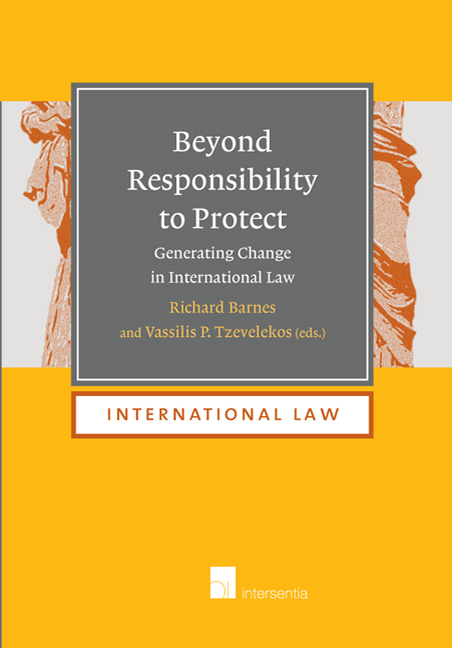Book contents
- Frontmatter
- Dedication
- Foreword
- Acknowledgements
- Contents
- Table of Cases
- List of Authors
- Introduction
- Part I The Moral Underpinnings and Political Ends of R2p
- Part II International Institutions And Their Role In R2p
- PART III De Facto Regimes and Non-State Actors Within a State And as a State
- De Facto Regimes and the Responsibility to Protect
- ‘Guilty’ Governments and ‘Legitimate’ Leadership: The Concept of ‘National Authorities’ under the R2P
- Commentary: Who Cares?: The Primary Bearer of the Responsibility to Protect
- Part IV R2p and Due Dilligence Regarding the Conduct of Corporations
- Part V The Interaction Between R2p And Humanitarian Law Obligations To Protect Civilian Populations
- PART VI R2p and International Criminal Law Beyond the Four R2p Crimes
- Part VII R2p and its Possible Impact on the Law of International Responsibility
- Part VIII Concluding Observations
- Index
‘Guilty’ Governments and ‘Legitimate’ Leadership: The Concept of ‘National Authorities’ under the R2P
from PART III - De Facto Regimes and Non-State Actors Within a State And as a State
Published online by Cambridge University Press: 19 September 2018
- Frontmatter
- Dedication
- Foreword
- Acknowledgements
- Contents
- Table of Cases
- List of Authors
- Introduction
- Part I The Moral Underpinnings and Political Ends of R2p
- Part II International Institutions And Their Role In R2p
- PART III De Facto Regimes and Non-State Actors Within a State And as a State
- De Facto Regimes and the Responsibility to Protect
- ‘Guilty’ Governments and ‘Legitimate’ Leadership: The Concept of ‘National Authorities’ under the R2P
- Commentary: Who Cares?: The Primary Bearer of the Responsibility to Protect
- Part IV R2p and Due Dilligence Regarding the Conduct of Corporations
- Part V The Interaction Between R2p And Humanitarian Law Obligations To Protect Civilian Populations
- PART VI R2p and International Criminal Law Beyond the Four R2p Crimes
- Part VII R2p and its Possible Impact on the Law of International Responsibility
- Part VIII Concluding Observations
- Index
Summary
INTRODUCTION
The 2005 World Summit Outcome Document (WSOD) provides that ‘[e]ach individual State’ has a responsibility to protect (R2P) ‘its populations’ from genocide, war crimes, ethnic cleansing and crimes against humanity (R2P crimes). The WSOD also provides that the international community should: (a) ‘encourage and help’ states to fulfil their R2P; (b) apply peaceful measures in order to ‘help to protect’ a population from R2P crimes; (c) undertake a ‘timely and decisive’ response when ‘national authorities’ manifestly fail to protect the population from R2P crimes; (d) help ‘States build capacity’ to protect the population; and (e) assist states ‘which are under stress before crises and conflicts break out’. The foregoing provisions of the WSOD have been subsequently interpreted as clearly structuring R2P as a protection framework, not least in the United Nations Secretary-General's (UNSG) 2009 Report on the implementation of R2P. The UNSG considers that the WSOD's provisions on R2P formulate R2P as a three-pillar framework.
The UNSG's three-pillar formulation of R2P was endorsed by the overwhelming majority of states at the 2009 United Nations General Assembly (UNGA) thematic debate on R2P. Notably, there is now a whole body of state and international practice which refers to a particular pillar of R2P. A useful example of this is the practice which has developed in relation to Pillar One of R2P or, to use Gareth Evans words, ‘Primary R2P’. Primary R2P has been explicitly recalled in its own right in a variety of thematic and country-specific resolutions of the United Nations Security Council (UNSC) and the United Nations Human Rights Council (UNHRC). Perhaps most significantly, the UNSG selected Primary R2P as the topic of his 2013 annual report on the R2P doctrine. Similar trends in practice exist in relation to Pillars Two and Th ree of R2P.
Prima facie, the move in practice toward addressing the individual pillars of the R2P framework suggests that there is much less ambiguity about ‘what R2P is and is not’ than there was when the WSOD was adopted by consensus in 2005. However, closer examination of recent R2P practice suggests that some components of R2P are still giving rise to competing interpretations among states and, therefore, merit further consideration. One example is the concept of ‘national authorities’.
- Type
- Chapter
- Information
- Beyond Responsibility to ProtectGenerating Change in International Law, pp. 175 - 192Publisher: IntersentiaPrint publication year: 2016



